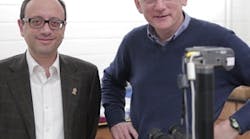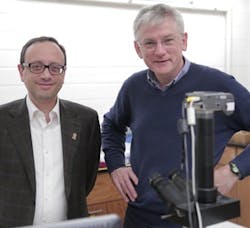Manos Mavrikakis and Nicholas L. Abbott, UW–Madison professors of chemical and biological engineering, developed a way to create inexpensive, portable and wearable chemical sensors for detecting explosives and industrial pollutants.
Chemical engineers from the University of Wisconsin–Madison (UW-Madison) have developed a way to create inexpensive, portable and wearable chemical sensors for detecting explosives and industrial pollutants.The sensors also could suit a variety of process monitoring applications including for fuel cells to detect the presence of carbon monoxide or sulfur-containing molecules and other gases that can poison electrodes and NO2 sensors for monitoring emissions.
“More broadly, they might be used to monitor exhausts from combustion processes, including coal combustion in power stations,” note Manos Mavrikakis and Nicholas L. Abbott, UW–Madison professors of chemical and biological engineering who worked on the project. “The sensors might also find use in biotechnology process monitoring, where sulfur- and nitrogen-containing molecules can indicate metabolic processes in a reactor,” they add.
[callToAction ]
Their approach uses computational chemistry and liquid crystals (LCs) to optimize LC-based sensor components: metal cations, salt anions, solvents, and molecules that form LCs. The sensor material consists of a thin film of metal salt, with LCs anchored to the surface in an ordered arrangement. The researchers designed specific LC molecules and metal cations so that small amounts of analyte would disrupt the interactions of the LCs on the surface; the change in the LCs would be a visible indicator of the analyte’s presence. After identifying promising candidates, the researchers used real-world measurements to further refine and improve their computational models. A recent article in Nature Communications provides more details.
“…If the interaction of a metal cation with the analyte is stronger than the interaction of the metal cation with the LC, then the LC will be displaced from the metal cation, resulting in an optical transition (dark to bright), which can be easily seen with the naked eye. The strength of these two key interactions strongly depend on the identity of the metal cation, the molecular structure of the LC molecule and the analyte, the chemical identity of the anions surrounding the metal cations, and any other parameters defining the metal cations’ immediate environment. By fine-tuning these parameters, we can modulate the strength of the two key interactions and develop sensors which respond to only one specific analyte (selective response) from a mixture of molecules at the vicinity of the sensor,” explains Abbott.
The researchers already have demonstrated parts-per-billion sensitivity. “The sensitivity depends on many factors, including the strength of binding of the analyte and the time over which the analyte is allowed to react with the surface. It is possible that in the future we may be able to achieve sub-ppb sensitivity. The computationally-based search for cations with high binding strengths for analytes and suitably weaker binding strengths for liquid crystals will be particularly useful in this context,” they note.
“We envision that following this computational methodology, we could potentially expand the range of sensors for the selective detection of hydrogen cyanide, ozone, halogen-containing compounds, ethylene oxide, nitric oxide, carbon monoxide, ammonia, chlorine, and other molecules of interest,” explains Mavrikakis.
Fabricating the sensors is no more complicated than those used to make electronic chips, the researchers note. “The cost of the materials involved in the sensors is low — making possible the fabrication of sensors with material costs under a dollar,” they add.
The compact, passive and lightweight nature of the sensors makes them highly suitable as wearable, badge-like sensors.
The sensors also are quite robust, say Abbott and Mavrikakis. Unlike past LCs, sensors can now be fabricated to withstand a wide humidity and temperature range. However, future work will address any potential susceptibility to poisoning. “When engineering the sensors at the molecular scale, we will be considering their response to molecules (other than the analyte) that could interfere with their specific operation to detect the analyte of interest, including potential poisons,” the researchers note.
In addition, the duo looks to further improve the accuracy of their models.
“The accuracy of our predictive capabilities strongly depends on describing the details of the chemical environment the sensing site is operating at. More elaborate models are currently under development, including explicit effects of solvents, anions, etc., which would enable us to improve the description of the displacement event that triggers the optical signature of the transition. We expect to complete the next generation of models within a year or so,” they note.



